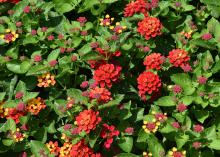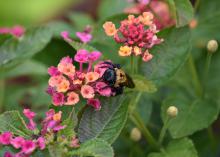Information Possibly Outdated
The information presented on this page was originally released on March 26, 2018. It may not be outdated, but please search our site for more current information. If you plan to quote or reference this information in a publication, please check with the Extension specialist or author before proceeding.
Reliable lantana blooms in summer landscapes
I took a look at my landscape this weekend trying to decide how many plants, if any, I’m going to have to renovate or replace after our hard winter. I have to say I was really impressed at the regrowth so far this spring.
One factor that contributed to most of my plants surviving was me providing freezing temperature protection.
Since I grow almost entirely in containers that range in size from 1 gallon all the way up to 25 gallons, I was able to bring much of my landscape into the garage. My containers spent 14 out of the first 21 days of January indoors, including my entire citrus orchard in 25-gallon pots.
With those cold memories behind us, now we need to think about the hot summer we know is coming. I count on reliable plants to perform their jobs in the summer season. And maybe at the top of my list of must-grow summer plants is lantana.
There are many great selections available for our gardens, from 4-foot specimens to sprawling ground-cover choices, along with just too many colors to list. Lantanas are so perfect for our Mississippi landscapes that two varieties have been chosen twice as Mississippi Medallion winners: New Gold and Sonset.
One of my favorite lantanas to use as a ground cover is definitely Luscious Lemonade. The flowers are sunshine yellow, and when viewed early in the morning, especially when there is dew on the plant, the flowers take on a two-toned appearance.
A new addition to the Luscious series is Royale Cosmo, which produces a seemingly endless amount of flower clusters showing off magenta-purple with orange-yellow flowers. I grew Royale Cosmo last year and am going to enjoy it again this summer.
A lantana I became acquainted with last year was Bloomify. This group produces flowers all summer long and, unlike some of the older lantana varieties, it does not produce any seed. Bloomify Red features bright-red flowers, and Bloomify rose has soft-pastel flowers in rose-pink. The plants remain neatly branched and reach about 14 inches tall and wide, which makes Bloomify lantana perfect for mass planting.
The only significant pest I watch out for is lantana lace bug. This bug produces leaf stippling and tar-like frass on the undersides of leaves, very similar to the damage caused by azalea lace bugs. Heavy infestations reduce flowering and even cause the plant to defoliate.
Prevent this problem by applying systemic insecticides to the plant root zone in May and July. Systemic insecticides include dinotefuran (such as Greenlight Tree and Shrub Insect Control with Safari) and imidacloprid (such as Bayer Advanced Garden Tree and Shrub Insect Control).
Light pruning through the summer helps maintain the size and tidiness while stimulating more flowering and a bushier structure. Fertilize twice per month with a water-soluble fertilizer to maintain flowering potential. In the early spring -- now is the perfect time -- cut them back hard to about 4 to 6 inches from the ground to make room for new growth.
Always plant lantanas in full sun locations with good landscape bed drainage. Once established, lantanas are drought tolerant. During these times, the flowering show will make your landscape pop.
Lantanas not only brighten the landscape but are also literal butterfly and pollinator magnets.
For more information and to see these lantanas growing in the landscape, check out the Southern Gardening segment Fall Lantana, https://www.youtube.com/watch?v=O6Gb20pCSnc .




